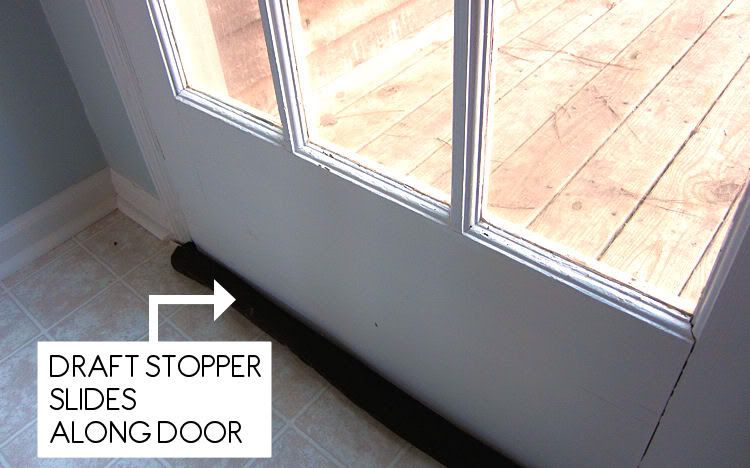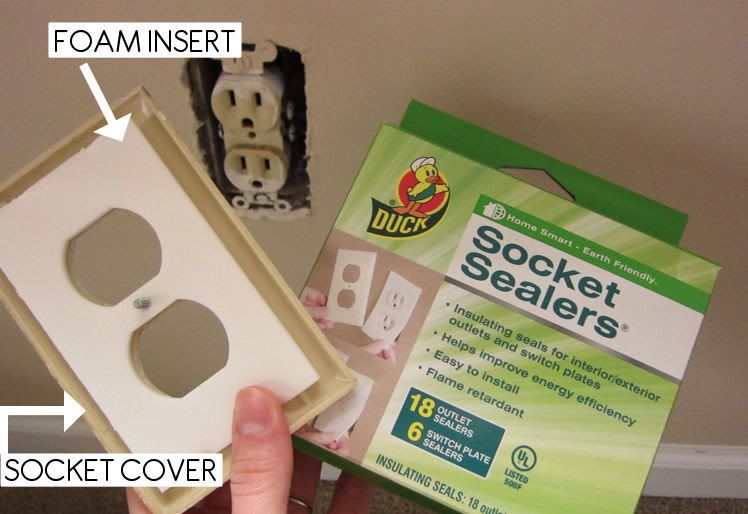Even before we were dreaming up paint colors and furniture arrangements, we were researching ways to weatherize our home to make it more energy-efficient for the changing seasons. One of the surprising things I learned was that, while we think that a lot of insulation has to happen in the ceilings and walls, your windows, doors and even your light switches can add up to a significant amount of lost air if not properly insulated.

This pie chart from The Sierra Club divvys up where most houses experience air leaks and doors and windows are more than 20 percent. The typical hotspots for insulation--attic, floors and walls—add up to about 30 percent of air loss. But if you look at the costs of insulating, you’ll see that patching up your leaky windows and doors is a no-brainer: To insulate a small attic will cost hundreds, but to add weather-stripping to your windows, doors and fixtures? You can probably accomplish it well under $100.
While we do plan on adding insulation to the attic, we decided that the first order of business would be to attack these other air leaks, first, thanks to Duck brand, who sent me a variety of winterization products to use to shore our new house up against the elements.
The first thing you need to do is figure out where you’re experiencing leaks. I found that it was easiest to locate those leaks when there was a big storm going on outside with strong winds. I just walked around from room to room and stood in front of the windows and doors and used Post-Its to mark where there were drafts. Then, I rounded up some supplies and went to work.
Many doors have little gaps running all around them that let air stream out. To stop that, you can pick up a door weatherization kit that has rubber on one side and an adhesive on the other that attaches to the door jamb. (Did you know that’s what the part around the door is called? The things you learn when you buy a home!) All you need are scissors to cut the rubber to size and then adhere. Pretty simple, and the one from Duck is guaranteed to last 10 years!

However, the door to our deck has an extra-large gap along the bottom, which we fixed up using a draft stopper from Duck that slips around the bottom of the door like a glove. Though it is obviously noticeable, I loved the simplicity of this solution! For instance, it is almost foolproof to use, doesn’t require any additional adjustments (it slides with the door), and also can be removed and reused any time you move or need it in a different location. Plus, you can also print out a coupon for the draft stoppers.
With the doors better sealed, then we moved on to the windows. Fortunately, the previous owners left storm windows on almost all of the house’s windows, which is a great first step to cutting down air loss. But if you don’t have those (or for even more added protection), you can turn to old-fashioned window plastic , which is barely noticeable and incredibly easy to apply, thanks to the pre-taped sheets that come with the roll-on kit from Duck. (You can also download a coupon for this kit.)

One of my favorite fixes for the windows was the rope caulk they sent, which requires absolutely no tools whatsoever. You just open the package, unroll a length of moldable caulk, push it into place along the edge where air is leaking, and you’re done. You can stretch it or double it up depending on the thickness your window needs, which I really liked. Plus, it seems really sturdy and is paintable and removable—making it a solution that will fit any number of living situations. (I found that it's best to use along the bottom of a drafty window, like how I used it, where there isn't much friction against it.)
And, while windows and doors are some biggies for losing heat, there are also a lot of surprising little ways heat escapes. Like through your wall sockets. (Just check out the picture below to see all that open space that sits behind the cover and can let outside air seep in.) According to the Sierra Club pie-chart, it only accounts for about 2 percent of loss, but it’s a pretty easy fix by popping in pieces of pre-cut foam that fit beneath the wall covers. It only took me about a half an hour to go around the house and add the inserts to all the sockets and switches along our exterior walls (where the loss is the greatest). And I still have extra inserts left over from a single package!

All in all, they were really simple swaps to help make our new home more energy efficient. And aside from the plastic window coverings, all of those changes are durable and should last for years before having to be replaced. Saving time, money and a little bit of Mother Nature, too? That’s my kind of home-improvement project!
To find out more about weatherization products from Duck, visit their site here. You can also "like" them on Facebook or follow them on Twitter for their latest updates.
Related Posts
Getting a Little Taste of Home Ownership
A Prayer for a “Humble but Sturdy” Home





Great ideas...I didn't know they made socket insulators. Our home is about 100 years old, and some places are drafty as all get out. :)
ReplyDeleteThese are great tips! Surprisingly, I've never seen these type of products before and after years of being a renter, it still seems something worthwhile spending money on to cut back on our utility bill.
ReplyDeleteGreat ideas! It is sure surprising what those little drafts add up to~!
ReplyDeleteGlad to be able to pass the tips and product suggestions along. They are so easy to implement and I truly believe that every little bit helps!
ReplyDeletedifferentparent, the house I grew up in was about 100 yrs old, too, so I definitely know what you're talking about!! Stay warm!
Urban Wife, I wish I would have looked into using some of these products more when I was renting because they really are so cheap and it's a worthwhile investment when you figure you can be that much warmer!
labbie1, I know! I was surprised at all the little places that my warm air sneaks out throught!